Altitude Sickness Prevention & Treatment Checker
Enter Your Ascent Details
Recommendation
Quick Take:
- Ascend slowly, drink plenty of water, and limit alcohol.
- Take acetazolamide 125mg twice daily if you’re going above2,500m.
- At the first sign of nausea, stop, rest, and consider supplemental oxygen.
- Descend 500‑1,000m or more if symptoms worsen.
- Know when to call for medical help - severe headache, confusion, or inability to walk.
What is altitude sickness a collection of symptoms that appear when the body can’t get enough oxygen at high elevations?
When you climb above roughly 2,500m (8,200ft) the air gets thinner, meaning less oxygen per breath. Your body reacts by increasing breathing rate, heart rate, and producing more red blood cells. If the climb is too fast, those adjustments can’t keep up and you start feeling ill - that’s what doctors call altitude sickness, also known as acute mountain sickness.
Why does nausea a queasy, unsettled feeling that often leads to vomiting show up?
Nausea is one of the most common early clues that your brain isn’t getting enough oxygen. The inner ear, which helps with balance, also gets affected, creating a mismatch that triggers the stomach‑brain reflex. In addition, reduced oxygen can slow digestion, making the stomach feel “off” and prompting that queasy sensation.
Key symptoms and when the situation becomes serious
- Headache that won’t go away
- Persistent nausea painful, unsettled feeling causing vomiting or loss of appetite
- Dizziness or light‑headedness
- Fatigue and trouble sleeping
- Swelling of hands, feet, or face (high‑altitude edema)
If you notice confusion, inability to walk straight, or a rapid decline in mental clarity, you may be slipping into high‑altitude cerebral edema (HACE) or pulmonary edema (HAPE) - both are medical emergencies that require immediate descent and professional care.
Prevention strategies that actually work
- Gradual ascent - Climbing no more than 300-500m (1,000-1,600ft) per day above 2,500m gives your body time to produce extra red blood cells. A rest day every 1,000m also helps.
- Hydration - Aim for 2.5-3L of fluid daily. Water, electrolyte drinks, and herbal teas keep blood volume up, which eases oxygen delivery.
- Limit alcohol and nicotine - Both constrict blood vessels and worsen dehydration.
- Eat a balanced, high‑carb diet - Carbohydrates need less oxygen to metabolize, providing quicker energy.
- Pre‑acclimatization - Spending a night in a hypoxic tent or doing “hill repeats” a few weeks before a big climb can prime your body.
- Medication prophylaxis - See next section for drug options.
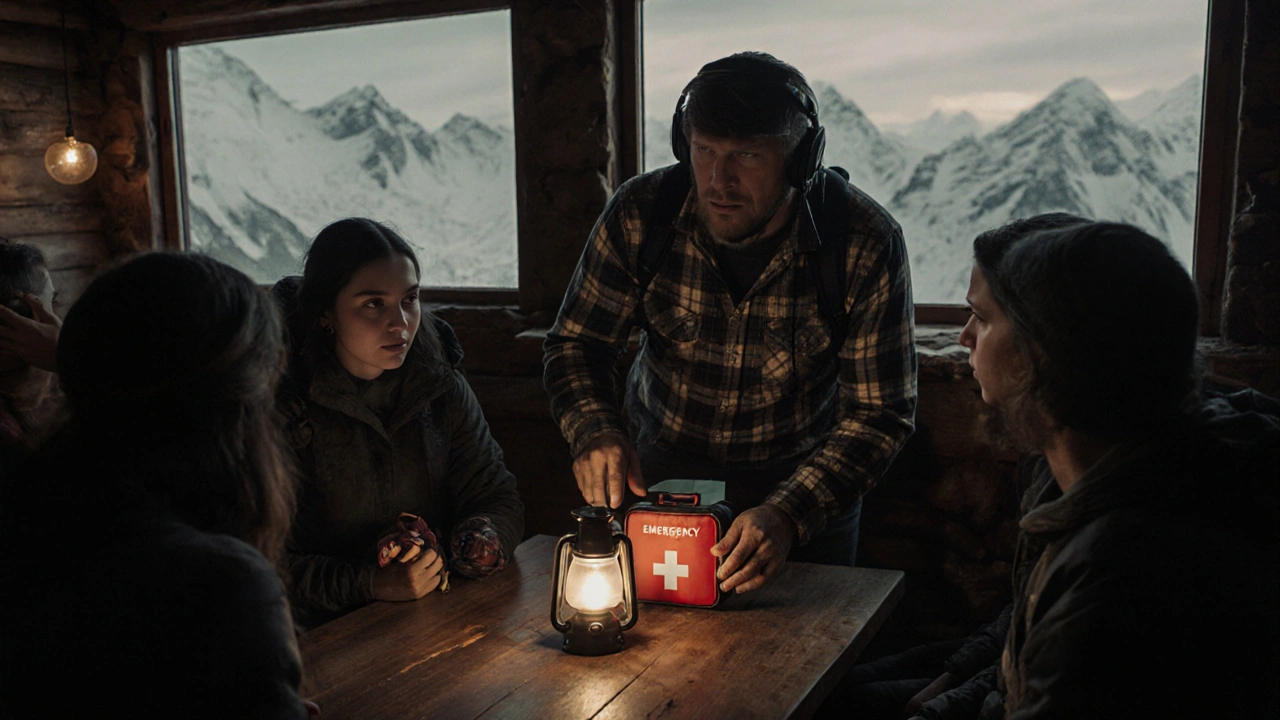
Medication prophylaxis: what to consider
Two drugs dominate the prevention playbook: Acetazolamide a carbonic anhydrase inhibitor that stimulates breathing and Dexamethasone a corticosteroid that reduces brain swelling. Both have proven efficacy, but they serve slightly different roles.
| Medication | Typical dose | Onset of action | Common side effects | Best for |
|---|---|---|---|---|
| Acetazolamide | 125mg twice daily starting 24h before ascent | 2‑4hours | Tingling hands/feet, mild diuresis, metallic taste | General prophylaxis above 2,500m |
| Dexamethasone | 2mg every 12h for high‑risk climbs | 1‑2hours | Increased appetite, insomnia, mood changes | People with history of severe AMS or when acetazolamide is contraindicated |
| Ibuprofen a non‑steroidal anti‑inflammatory drug used for pain relief | 400‑600mg every 6‑8h as needed | 30minutes | Stomach upset, mild dizziness | Relieving headache or mild muscle pain, not a primary preventive drug |
Acetazolamide works by making your blood slightly more acidic, which forces you to breathe faster, boosting oxygen intake. Dexamethasone, on the other hand, quiets inflammation in the brain, buying you time if symptoms start to flare.
Immediate treatment steps when nausea strikes
- Stop the climb - Rest at your current altitude for 30‑60minutes.
- Hydrate - Sip water or an electrolyte solution; avoid caffeine.
- Use an oxygen therapy portable O₂ tanks or concentrators delivering supplemental oxygen if you have it. A flow of 2-4L/min can dramatically reduce nausea within minutes.
- Take an anti‑nausea medication, such as Meclizine an antihistamine that alleviates motion‑related nausea (25mg every 6h). It won’t cure altitude sickness but can let you eat and sleep.
- If symptoms persist or worsen after an hour, descend at least 500m (1,600ft). Even a short drop in altitude can relieve the queasy feeling.
When to call for professional help
Most hikers can manage mild nausea with rest and hydration, but these red flags demand immediate action:
- Severe, throbbing headache unresponsive to ibuprofen.
- Persistent vomiting that leads to dehydration.
- Confusion, slurred speech, or impaired coordination.
- Shortness of breath at rest or a cough producing frothy sputum.
- Rapid heart rate (over 120bpm) coupled with low oxygen saturation (<85%).
If you’re in a remote area, call the local rescue service, use a satellite messenger, or hand‑signal for help. Have a plan in place before you set out - a small emergency kit with a portable oxygen can, anti‑nausea tablets, and a written evacuation route can save lives.
Putting it all together: a sample altitude‑acclimatization schedule
- Day 1: Arrive at base camp (1,800m). Hydrate, avoid alcohol.
- Day 2: Ascend to 2,200m, sleep. Take acetazolamide 125mg twice.
- Day 3: Rest at 2,200m, monitor for nausea.
- Day 4: Climb to 2,700m, continue medication.
- Day 5: If no symptoms, move to 3,200m; otherwise, stay one more night.
- Day 6+: Repeat 500m increments, always allowing a rest day after each gain.
The key is listening to your body. If nausea pops up early, pause the schedule and give yourself an extra day to adapt.
Quick checklist before you head up
- Pack acetazolamide (if recommended) and anti‑nausea meds.
- Bring a portable oxygen can or know the nearest treatment station.
- Charge a satellite communicator.
- Check weather - rapid ascents in cold, windy conditions increase risk.
- Inform someone of your itinerary and expected return time.
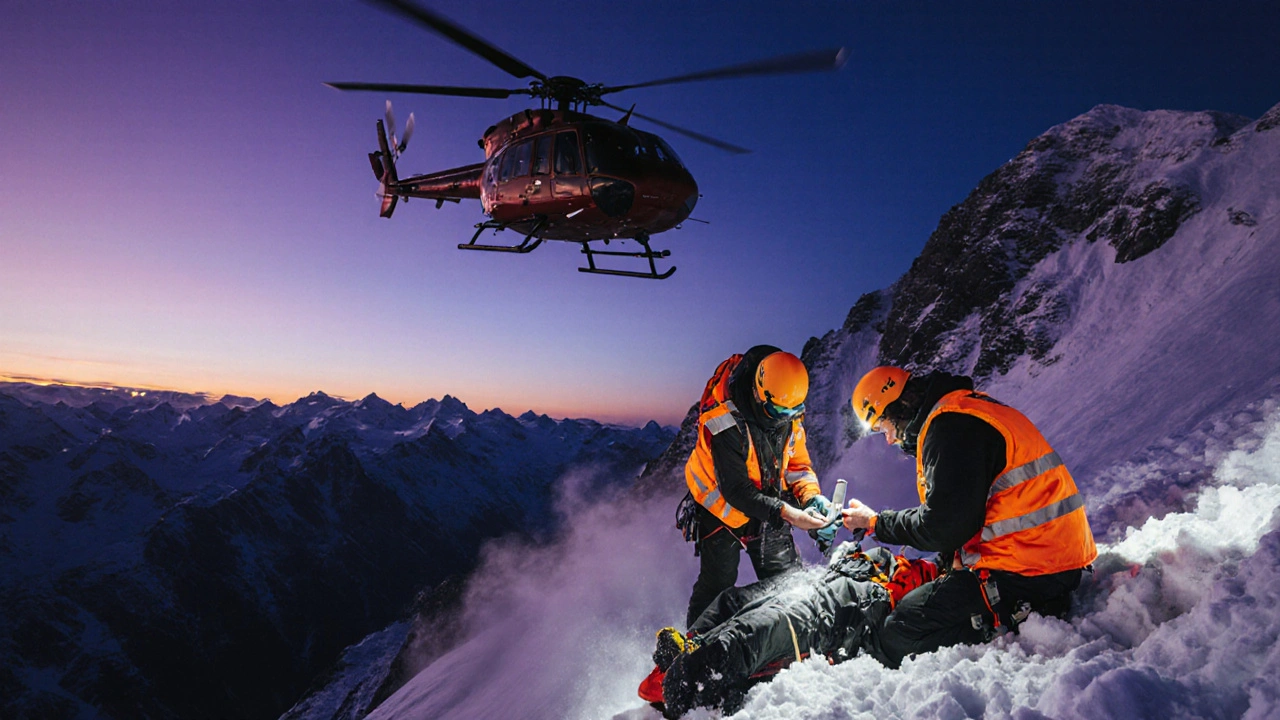
Frequently Asked Questions
Can I prevent nausea without medication?
Yes. A slow ascent, plenty of water, a high‑carb diet, and avoiding alcohol or heavy meals before climbing can often keep nausea at bay. However, if you’re heading above 3,500m, a low‑dose acetazolamide regimen is still the most reliable safety net.
Is it safe to take acetazolamide if I have a history of kidney stones?
Acetazolamide can increase urinary alkalinity, which may promote certain types of stones. Talk to a doctor first; they might suggest a reduced dose or an alternative like dexamethasone, especially if you’ve had stones in the past.
How long does supplemental oxygen stay effective at 4,000m?
A portable cylinder delivering 2-4L/min can raise blood oxygen saturation from ~80% to >95% within minutes, easing nausea and headache. The bottle typically lasts 4‑6hours at those flow rates, sufficient for a short descent or a rest stop.
What’s the difference between acute mountain sickness and high‑altitude cerebral edema?
Acute mountain sickness (AMS) is the mild to moderate set of symptoms-headache, nausea, fatigue-that usually resolve with rest or descent. High‑altitude cerebral edema (HACE) is a severe, life‑threatening swelling of the brain that presents with confusion, ataxia, and inability to walk. HACE requires immediate descent and emergency medical treatment.
Can I use ibuprofen to treat nausea?
Ibuprofen helps with headache and muscle aches but does not directly calm the stomach. Pair it with an anti‑nausea drug like meclizine if nausea dominates your symptoms.
By planning ahead, pacing your ascent, staying hydrated, and knowing which meds can help, you’ll keep nausea-and the whole altitude‑sickness cascade-under control. Remember: the mountain will always be there; your health isn’t.

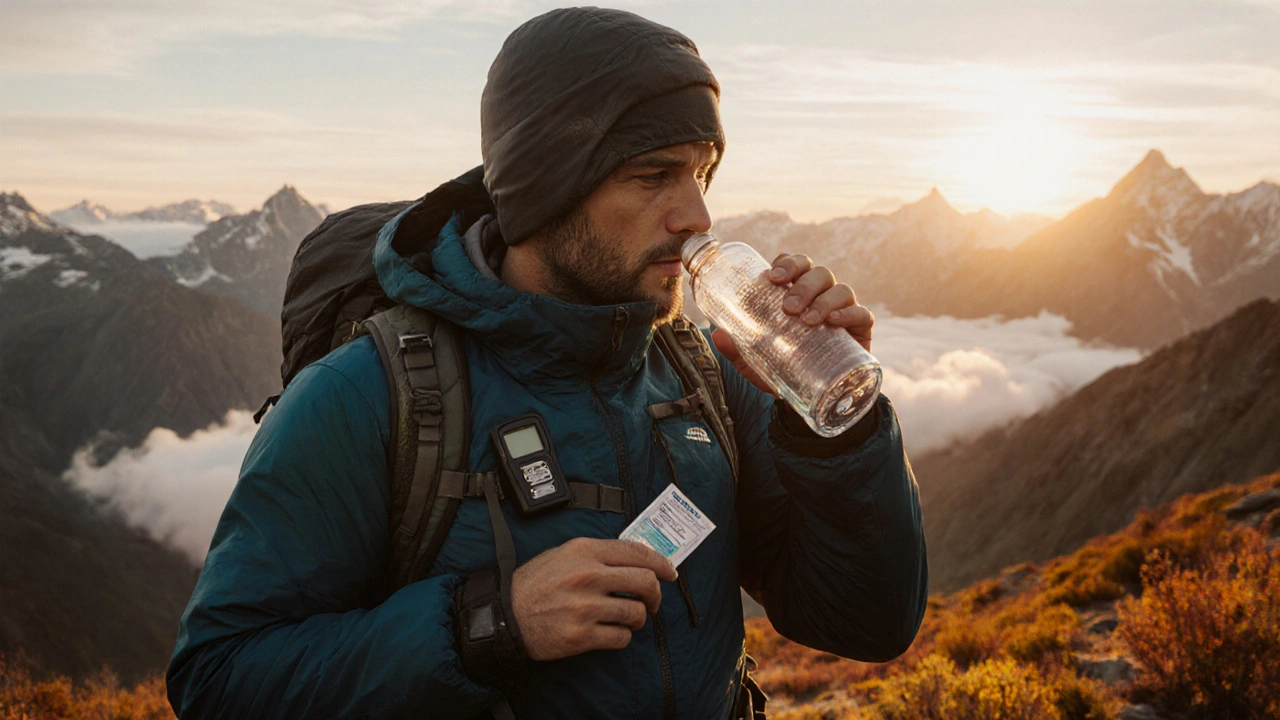


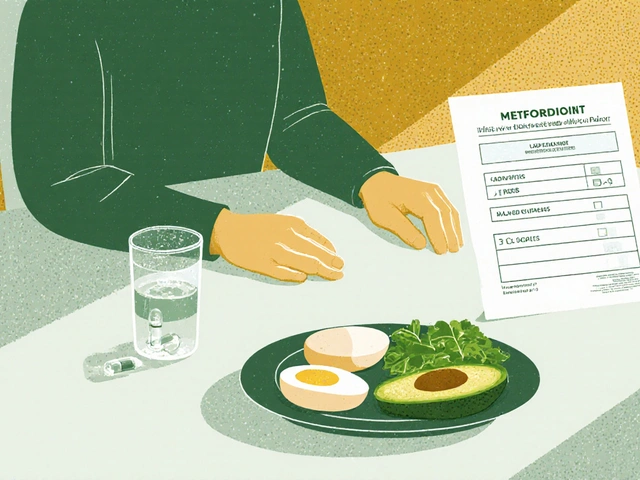


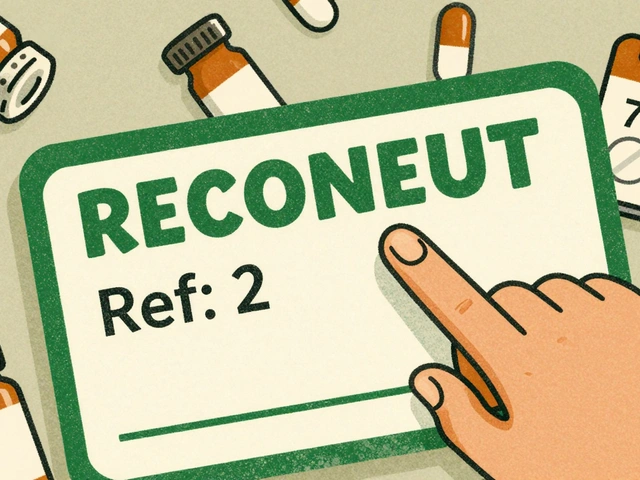
17 comments
Erica Harrington
I love how the guide emphasizes gradual ascent and staying hydrated. Keeping your pace under 500 m per day above 3 000 m really cuts down the nausea risk. Also, the tip about sleeping at the same altitude before pushing higher is solid. Remember to listen to your body and turn back if symptoms linger.
Patricia Mombourquette
this article gets it right but i cant believe people still ignore basic altitude rules its simple stay hydrated don’t rush
karl lewis
While the practical advice is commendable, one must also consider the metaphysical implications of ascending beyond the familiar. The mountain, in its grandeur, serves as a reminder of humanity's petite stature. Yet, the recommended acetazolamide dosage aligns with established protocols. 😊
Amy Martinez
Reading through the prevention checklist felt like getting a lifeline before a long trek. First, the reminder to ascend no more than 300‑500 m per day above 2 500 m is a cornerstone that many overlook, and it truly helps the body acclimatize. Second, the emphasis on staying well‑hydrated with electrolytes, rather than just water, prevents both dehydration and electrolyte imbalance, which can magnify nausea. Third, the suggestion to take a short rest day every 1‑2 days gives the respiratory system a chance to adapt without being pushed to the limit. Fourth, the recommendation to start a low‑dose acetazolamide regimen before the ascent gives the kidneys a head start on acid‑base balance, reducing the AMS cascade. Fifth, the tip about avoiding alcohol and heavy meals at altitude is practical; both can exacerbate dehydration and gastric upset. Sixth, the article’s reminder to monitor oxygen saturation with a pulse oximeter provides a concrete metric for early detection. Seventh, the suggestion to descend immediately if severe symptoms develop, even if that means losing a hard‑earned summit, underscores safety over ego. Eighth, the mention of using a portable oxygen canister for short descents adds an extra safety net for those who feel faint. Ninth, the inclusion of simple breathing exercises, like the 2‑1‑2 technique, offers a non‑pharmacological way to manage dyspnea. Tenth, the guidance to keep a symptom diary helps hikers recognize patterns before they become dangerous. Eleventh, the reminder that weather changes can intensify altitude effects encourages climbers to stay flexible with their schedule. Twelfth, the advice to dress in layers prevents both overheating and rapid cooling, both of which can destabilize the body’s response. Thirteenth, the note that prior fitness training improves overall tolerance, yet does not replace proper acclimatization, dispels a common myth. Finally, the overall tone of the article mixes scientific rigor with relatable anecdotes, making the information both trustworthy and accessible. All these points together create a comprehensive roadmap that can keep nausea and other altitude‑related woes at bay.
Josh Grabenstein
just think how pharma pushes meds like acetazolamide they want you dependent and never tell you about natural oxygen therapy
Marilyn Decalo
Honestly, the whole “just take a pill and you’ll be fine” narrative is pure drama-real climbers know you can’t cheat your biology with a few tablets.
Mary Louise Leonardo
maybe but those pills are literally lifesavers when you’re above 5000ft i swear the mountain doesn’t care about drama only physics
Alex Bennett
It’s interesting how the guide balances medical advice with practical field tips; the recommendation to carry a pulse oximeter is especially useful for early detection. While I appreciate the thoroughness, I’d also add that mental preparation plays a role-visualizing the ascent can reduce anxiety‑induced nausea. Overall, the article offers a solid foundation for safe climbing.
Mica Massenburg
yeah but i heard the government hides data on altitude illnesses to keep tourism numbers up
Sarah Brown
Great summary! Remember, every hiker should pair this knowledge with a buddy system-having a partner watch for subtle signs can prevent a crisis before it escalates.
Max Canning
Excellent tips!
Nick Rogers
Indeed, the article’s emphasis on gradual ascent, proper hydration, and appropriate medication, such as acetazolamide, provides a comprehensive strategy, and the inclusion of symptom monitoring tools, like pulse oximeters, further enhances safety.
Tesia Hardy
I think this guide is super helpful, it really covers all the bases and i love the friendly tone. Just make sure to double‑check the dosage instructions and keep an eye on your body's signals.
Matt Quirie
Thank you for the thorough overview; the step‑by‑step recommendations, including rest days, hydration strategies, and medication guidelines, are invaluable, especially for novice climbers; the additional safety tips, such as using pulse oximeters and carrying oxygen canisters, further underscore the article’s practical utility.
Pat Davis
From a cultural perspective, the article respectfully acknowledges traditional high‑altitude practices while integrating modern medical guidance; this balanced approach honors indigenous knowledge and promotes safety for all adventurers.
Mary Wrobel
Hey folks, love how this piece blends science with real‑world advice-keeps things clear and easy to follow without any cheesy emojis.
Lauren Ulm
Definitely a solid read 😊 the mix of practical tips and a nod to the psychological side of altitude sickness makes it well‑rounded. 🚀